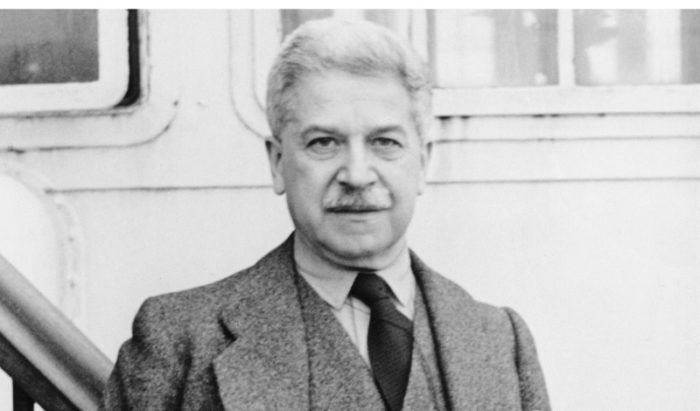
Sonate n°18 Op.31 n°3: 25 Mars 1932
Sonate n°28 Op.101: 24 Avril 1934
Sonate n°22 Op.54: 11 Avril 1933
Sonate n°8 Op.13: 2 Octobre 1933; 23 Avril 1934
Sonate n°3 Op.2 n°3: 26&27 Avril 1934
Artur Schnabel, piano
London Abbey Road Studio n° 3 – Engineer: Edward Fowler – piano: Bechstein
Source: disques 33 tours « The HMV Treasury »
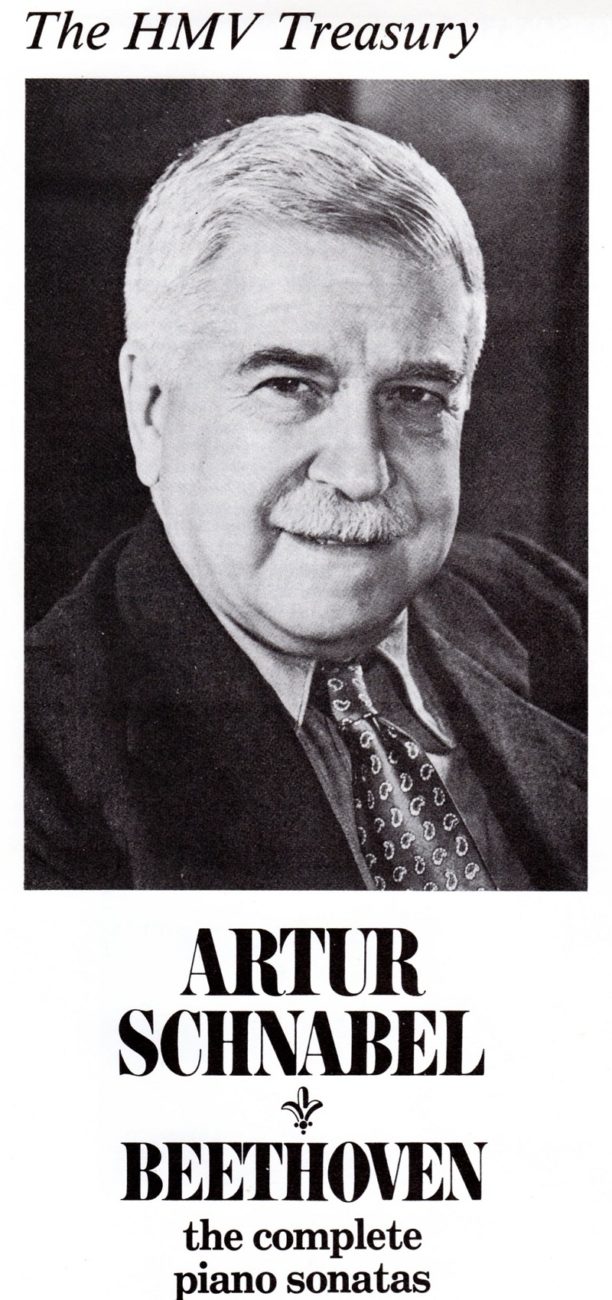
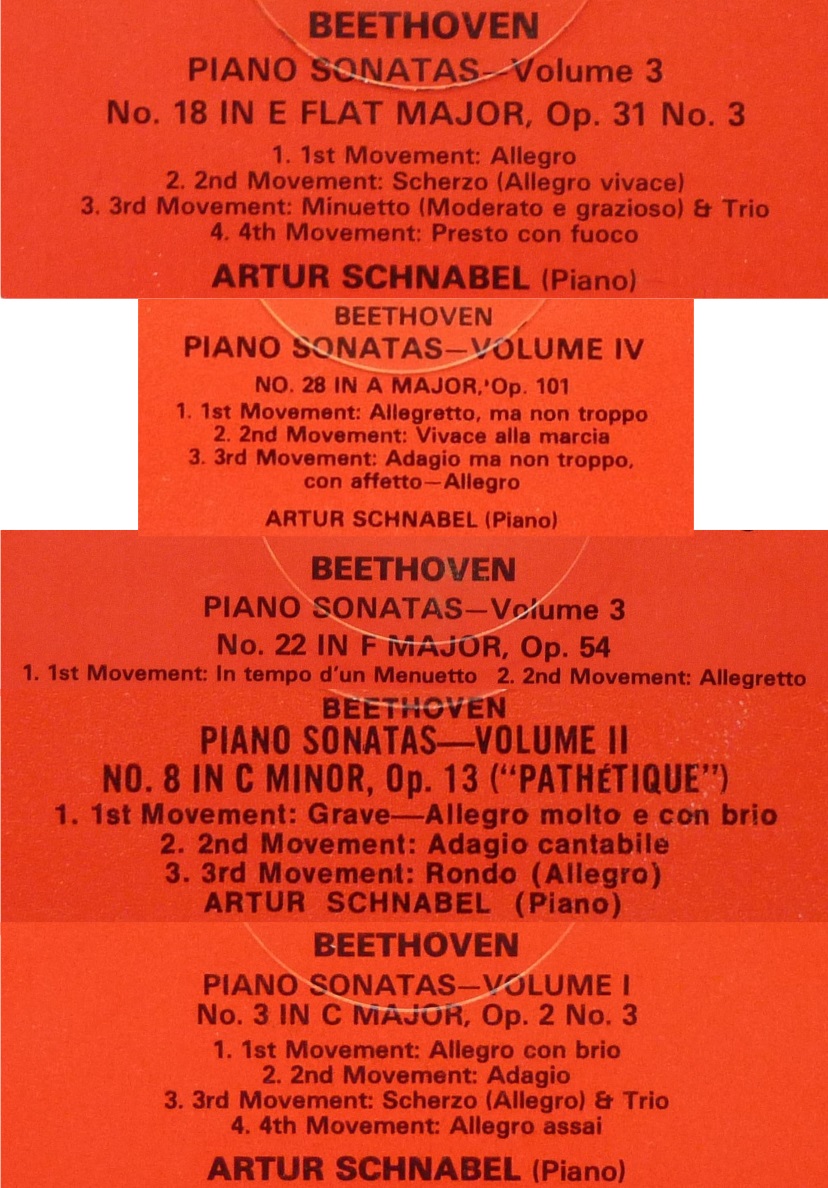
Le deuxième programme de l’intégrale des 32 sonates de Beethoven par Artur Schnabel comportait les cinq sonates ci-dessus, dont les deux premières ont été jouées en première partie de concert.
Pour plus de détails sur les sept récitals de cette intégrale, cliquer ICI
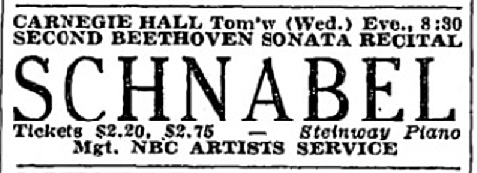
Pour le deuxième concert (22 janvier) de l’intégrale donnée à Carnegie Hall en 1936, nous disposons de la critique d’Howard Taubman qui va pour l’essentiel dans le même sens que son confrère Olin Downes: Il souligne tout d’abord à quel point l’oreille était réjouie par une richesse de phrasés, de nuances et de dynamique tout le long de chaque œuvre, que cependant l’auditeur n’avait jamais son attention détournée par des fragments, mais qu’il était conduit à voir toute la logique de chaque composition. Il note également que la réussite de ce récital ne pouvait que rendre difficile de soutenir l’objection de certains que les interprétations de Schnabel seraient trop intellectuelles, et que l’émotion en serait évacuée par la prééminence de la tête sur le cœur, car il à joué avec brillance et tempérament. Et que si le pianiste ne laissait pas libre cours à son tempérament, c’était pour de bonnes raisons.
« La sonate dite « Pathétique » (n°8 Op.13) a été jouée avec incandescence, sans qu’elle puisse virer à la sentimentalité. La sonate en mi bémol majeur (n°18 Op.31 n°3) était vibrante, et pleine de brio. Et pour une pleine compréhension de la profondeur de l’imagination de M. Schnabel, il faut mentionner la grandeur et la noblesse de son jeu dans l’Op.101 (n°28). Le public a une nouvelle fois écouté dans un silence qu’on ne rencontre que lors d’événements rituels comme le cycle Wagner en matinée au Metropolitan. »
Artur Schnabel’s second program of the complete Beethoven sonatas was comprised of the above mentioned five sonates, two of which being played before the intermission.
For a detailed description of the seven programs of his complete performances of Beethoven’s 32 sonatas, click HERE

For the second concert (22 January) of the complete performance of the 32 Sonatas given at Carnegie Hall in 1936, we have an article by Howard Taubman who basically shares the view of his associate Olin Downes: He underlines in the first place that the ear caught innumerable felicities of phrase, nuance and dynamics, as a work pursued its course and that the auditor nevertheless was never deterred by fragments, but compelled to see the complete logic of each composition. Objecting to his interpretations on the ground that they are intellectualized and that the emotion is wrung out by the predominence of the head over the heart is a thesis difficult to defend in the face of last night’s accomplishment. For Mr. Schnabel played with brilliance and temperament. True, his temperament was held in leash, and with good reasons.
« The sonata known as the « Pathétique » (n°8 Op.13) was played with enkindling warmth but it was not permitted to deteriorate into sentimentality. The E flat major sonata (n°18 Op.31 n°3) was vibrant, full of gusto. For a full comprehension of the profundity of Mr. Schnabel’s imagination, one must speak of the grandeur and nobility of his playing of Op.101 (n°28). The audience again observed the hushed attention that is only perceptible at ritual events like the Wagner matinee cycle at the Metropolitan. »

Sonate n° 15 Op.28: 3 & 17 Février 1933
Sonate n°31 Op.110: 21 Janvier 1932 (premier enregistrement de Schnabel)
Sonate n°1 Op.2 n°1: 23, 24 & 28 Avril 1934
Sonate n°16 Op.31 n°1: 5 & 6 Novembre 1935; 15 Janvier 1937 (face 4)
Artur Schnabel, piano
London Abbey Road Studio n° 3 – Engineer: Edward Fowler – piano: Bechstein
Source: disques 33 tours « The HMV Treasury »
Artur Schnabel a non seulement enregistré entre 1932 et 1935 la toute première intégrale des 32 Sonates pour piano de Beethoven, mais, à quatre reprises, il les a aussi jouées au concert à Berlin en janvier-février 1927, à Londres en octobre-novembre 1932, de nouveau à Berlin en janvier-avril 1933 et enfin à New York en janvier-février 1936, sous forme de cycles de sept récitals toujours composés de la même façon, chaque récital panachant soit quatre, soit cinq, sonates de différentes périodes. Pour plus de détails, cliquer ICI
Nous vous proposons d’écouter son intégrale enregistrée en reprenant le programme de chacun de ces sept récitals.
Pour le premier de ces programmes, nous disposons d’une critique tout à fait remarquable, un modèle du genre, écrite par Olin Downes après le récital à Carnegie Hall du 15 janvier 1936:
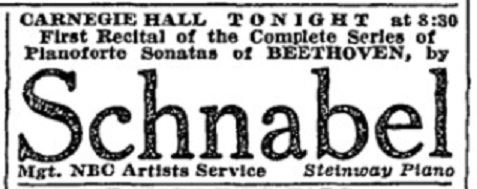
Downes mentionne tout d’abord que le public était composé en majorité de musiciens, d’étudiants et de mélomanes avertis et que de nombreux spectateurs suivaient attentivement sur la partition. Concernant le pianiste, il mentionne son sens de la grande ligne mais aussi du moindre détail, ainsi que la perfection des proportions, la profondeur de pensée et l’authenticité des sentiments qu’il projette, et enfin la simplicité sans ostentation de sa tenue en scène.
Il souligne que la musique est projetée avec une extraordinaire signification, car chaque sonate, qui est un monde en soi, est traitée comme telle en fonction de la nature de la musique et de la période qu’elle représente dans l’évolution de la pensée Beethoven. Et que cette communication s’établit sans que Schnabel ait jamais besoin « d’élever la voix du piano », car le timbre du piano et la pensée musicale se projettent dans le vaste espace de Carnegie Hall, grâce à une gamme de nuances très finement ajustée. Il note un remarquable degré de différentiation entre des accords « mezzo-piano » et « piano », entre le niveau dynamique de chaque note d’une courte phrase expressive ainsi que des gradations de tempo tout aussi subtiles, comme lors de la dernière apparition du thème dans le mouvement lent de la sonate dite « Pastorale » (n°15 Op.28).
Il note aussi l’objectivité de Schnabel, comme s’il nous disait: « Voici une sonate de Beethoven, et pour autant que j’aie pu le découvrir au cours d’une vie d’étude, c’est comme ceci que Beethoven voulait qu’elle sonne. Je le tiens de la partition de Beethoven que j’ai examinée dans toutes les versions, manuscrites et imprimées et dont ma propre édition énonce mes conclusions« . Ce que décrit ainsi Downes, c’est la filiation de Schnabel, qui composait de la musique atonale, non avec le romantisme, mais avec Arnold Schoenberg.
Concernant le programme joué ce soir là, Downes note de nouveau que chaque sonate y avait son propre style, et que la tranquillité de la sonate n°15 Op.28 qui ouvrait le concert constituait un prélude particulièrement approprié à la rhapsodie démoniaque et mystique de l’Op.110 (n°31), peut-être la plus mystérieuse de tout le cycle, dans laquelle Beethoven rêvait des rêves et avait des visions.
« Quant à la sonate n°1 Op.2 n°1, elle a été jouée avec la pleine prémonition de son caractère prophétique, mais sans exagération. Le mouvement lent a été chanté avec un parfait cantabile et un legato qu’on n’imaginerait pas au clavecin, mais avec une grâce mozartienne et une simplicité dans l’accentuation. Le Finale était plus qu’une prémonition du Beethoven en devenir, et du développement du mouvement romantique de la musique pour piano. Chaque sonate a été saluée par de longs applaudissements. »
La réédition de ces enregistrements a toujours été problématique en raison de l’adoption systématique par les éditeurs d’un filtrage du bruit de fond des 78 tours, qui se fait toujours aux dépens de la musicalité (nuances, phrasés, timbres et dynamique). Toutefois, en 1980/81, à l’occasion du Centenaire de la naissance de Schnabel, une série d’albums 33 tours sous le label « The HMV Treasury » a remarquablement restitué ces interprétations à partir de nouveaux reports effectués par Keith Hardwick dans les Studios d’Abbey Road à partir de pressages vinyle des matrices métalliques d’origine, dépourvus des bruits de surface des disques 78 tours commerciaux. Les éditions successives en CD (EMI et Warner) ont été décevantes à cause de l’usage systématique d‘un filtrage excessif. D’autres éditeurs (Pearl, Naxos) ont obtenu de meilleurs résultats à partir de 78 tours commerciaux, sans toutefois égaler les Albums « The HMV Treasury ».
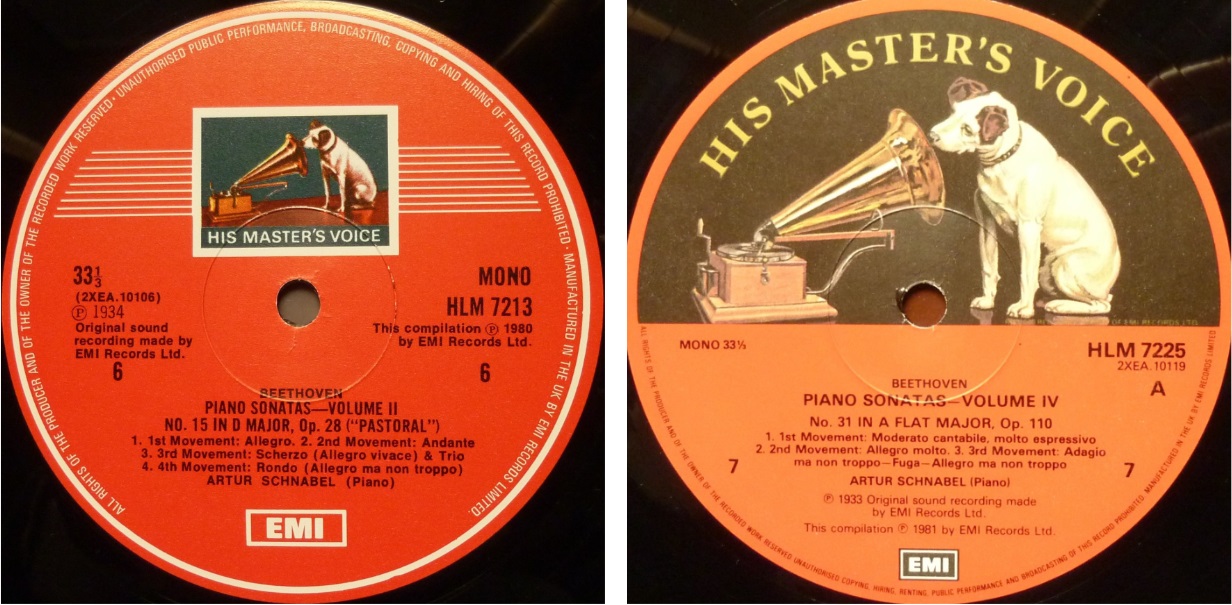

____________
Sonata n° 15 Op.28: 3 & 17 February 1933
Sonata n°31 Op.110: 21 January 1932 ( Schnabel’s first recording)
Sonata n°1 Op.2 n°1: 23, 24 & 28 April 1934
Sonata n°16 Op.31 n°1: 5 & 6 November 1935; 15 January 1937 (side 4)
London Abbey Road Studio n° 3 – Engineer: Edward Fowler – piano Bechstein
Source: LPs « The HMV Treasury »
Artur Schnabel has not only made between 1932 and 1935 the very first complete recording of the 32 piano Sonatas, but he also performed them four times during concert cycles in Berlin in January-February 1927, in London in October-November 1932, again in Berlin in January-April 1933 and lastly in New York in January-February 1936, each cycle of seven recitals always organized in the same way, each recital being comprised of either four or five Sonatas from different periods. For a detailed description, click HERE
We propose you to listen to his complete recording according to the program of each of these seven recitals.
For the first of these programs, we have an outstanding article, indeed a model, written by Olin Downes after the Carnegie Hall recital of 15 January 1936:

To start with, Downes mentions that the majority of the public consisted of musicians, students and serious music lovers and that a great many in the audience had scores to follow every note of the interpretations. As to the pianist, he notes his sense of the grand line and of the most significant finish of detail, as well as the perfect proportion, the depth of thought and the genuineness of feeling he conveys, but also his unostentasious manner and his simplicity on the platform.
He underlines that the music is projected with extraordinary significance. As each sonata is a different world in itself, so does the treatment of each one vary in accordance with the nature of the music and the period that it represents in Beethoven’s thought. And he establishes this communication never by « raising the piano’s voice », because the tone carries and the musical thought carries in the wide spaces of Carnegie Hall, and this by means of a very finely adjusted scale of values. He notes a remarkable degree of difference between chords « mezzo-piano » and « piano », between the dynamic value of each note of a short expressive phrase, as well as equally subtle gradations of tempo, witness the last appearance of the theme of the slow movement of the so-called « Pastoral »sonata (n°15 Op.28).
He also notes Schnabel’s objective vein, seeming to say: « This is Beethoven‘s sonata, so far as I have been able to discover in a lifetime of study, it is precisely as Beethoven wanted it to sound. My authority is Beethoven’s score which I have examined in all the existing manuscript and printed versions of which my own edition states my conclusions« . What Downes thus describes is the direct line of Schnabel, who composed atonal music, not with romantiscm, but with Arnold Schoenberg.
As to the program performed that evening, Downes notes again that each sonata had its special style, and that the tranquillity of sonata n°15 Op.28 that opened the concert made a particularly felicitious prelude to the demoniac and mystical rhapsody of the Op.110 (n°31), perhaps the most mysterious of the whole set, wherein Beethoven dreamed dreams and had visions.
« The sonata n°1 Op.2 n°1 was performed with the fullest realization of its prophetic character, but without forcing this note. The slow movement was sung with an immaculate cantilena and a legato that it would be hard to conceive as issuing from the harpsichord, yet with a Mozartian grace and simplicity of accent. The Finale was more than a premonition of the Beethoven to come, and indeed of the course of the romantic movement in piano music. There was long applause after each sonata. »
The reissue of these recordings was always problematic because of the systematic use by the editors of noise reduction to filter the background noise of the 78rpm, always detrimental to musicality (details, phrasings, timbres and dynamics). However, in 1980/81, with a view to celebrating the Centenary of Schnabel’s birth, a series of LP Albums under the label « The HMV Treasury » has remarkably restored these performances from fresh transfers made by Keith Hardwick at the Abbey Road Studios from vinyl pressings of the original metal parts, devoid of the background noise of the commercial shellack 78rpm. The later CD issues (EMI et Warner) were a failure because of the systematic use of excessive filtering. Other firms (Pearl, Naxos) obtained better results from commercial shellack pressings, without however matching the « The HMV Treasury » Albums.

Aafje Heynis, contralto – Wiener Symphoniker (WSO) dir: Hans Gillesberger
Johann Sebastian Bach
Matthäus-Passion BWV 244: Erbarme dich (Walter Schneiderhan, violon)
Weinachtsoratorium BWV 248: Bereite dich Sion
Johannes-Passion BWV245: Es ist volbracht (Nikolaus Hübner, violoncelle)
Messe h-moll BWV 232: Agnus Dei
Georg Friedrich Händel
Messiah: He was despised – O thou that tellest
Judas Maccabaeus: Father of Heaven
Samson: Return, o God of Hosts
Wien Juli 1960 (Bach), April 1961 (Händel)
La contralto néerlandaise Aafje Heynis (1924-2015) avait un timbre qui rappelait beaucoup celui de Kathleen Ferrier avec laquelle on la confondait souvent. Elle était une interprète incomparable de Bach et de Händel, et il est étonnant que, pour ses enregistrements intégraux des Passions de Bach avec l’ Orchestre du Concertgebouw, Eugen Jochum lui ait préféré la prosaïque Marga Höffgen.
Ces enregistrements n’en sont que plus précieux. Il serait par ailleurs souhaitable que son intégrale de la Matthäus-Passion au Festival de Naarden (12 avril 1960) sous la direction d’Anthon van der Horst soit rééditée.

The voice of the Dutch contralto Aafje Heynis (1924-2015) was very similar to Kathleen Ferrier’s and she was often mistaken for her. She was an outstanding interpret of Bach and Händel, and it is astonishing that, for her complete recordings of the Bach Passions with the Concertgebouw Orchestra, Eugen Jochum chose the rather prosaïc Marga Höffgen.
These recordings are all the more treasurable. A re-issue of her complete performance of the Matthäus-Passion from the Naarden Festival (12 April 1960) under the direction of Anthon van der Horst would be highly wishable.
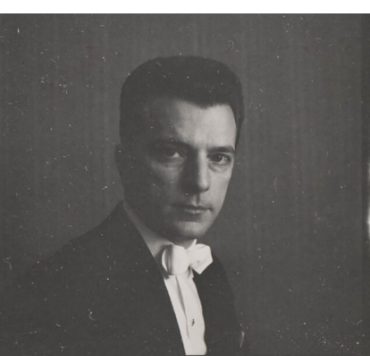
Brahms: Tragische Ouverture Op.81 NBC SO Manhattan Center – January 15, 1951
Brahms: Symphonie n°1 Op.68 NBC SO – Carnegie Hall – December 6, 1952
______
NYPO – Westminster Choir – Carnegie Hall – April 1, 1956
Verdi: Te Deum
Brahms: Alt-Rhapsodie Op.53 NYPO – Martha Lipton
Source: Bande/Tape 19 cm/s / 7.5 ips
Guido Cantelli a peu donné en concert l’Ouverture Tragique de Brahms Op.81, mais par contre sa Première Symphonie Op.68 est l’œuvre qu’il a le plus dirigé. Fin 1950, la NBC a transformé en studio de TV le studio 8-H où avaient lieu la plupart des concerts du NBC SO, et a décidé de les transférer au Manhattan Center, salle à l’acoustique très réverbérée, ce que Toscanini a refusé, seul Carnegie Hall étant pour lui acceptable, et donc seuls d’autres chefs d’orchestre, dont Cantelli, y ont donné temporairement des concerts avec cet orchestre, et la NBC n’a finalement pu que se plier à sa demande.
Le Te Deum de Verdi et la Rhapsodie pour contralto, chœurs d’homme et orchestre Op.53 de Brahms ont été mis au programme des concerts des 29, 30, 31 mars, et 1 avril 1956 du New York Philharmonic et c’est la seule fois qu’il les a dirigées.


Guido Cantelli has seldom performed Brahms’ Tragic Overture Op.81, whereas his first Symphony Op.68 was the work he most conducted. At the end of 1950, the NBC transformed Studio 8-H where most of the NBC SO concerts were given, into a TV studio, and decided to tranfer them to Manhattan Center, a venue with much reverberation, which Toscanini refused, only Carnegie Hall being acceptable to him, and thus only other conductors, among them Cantelli, temporarily gave concerts there with this orchestra and eventually the NBC had to comply with his demand.
Verdi’s Te Deum and Brahms’ Rhapsody for contralto, male chorus and orchestra Op.53 were performed at the New York Philharmonic concerts of March 29, 30, 31 and April 1, 1956 and it it the only time he performed them.
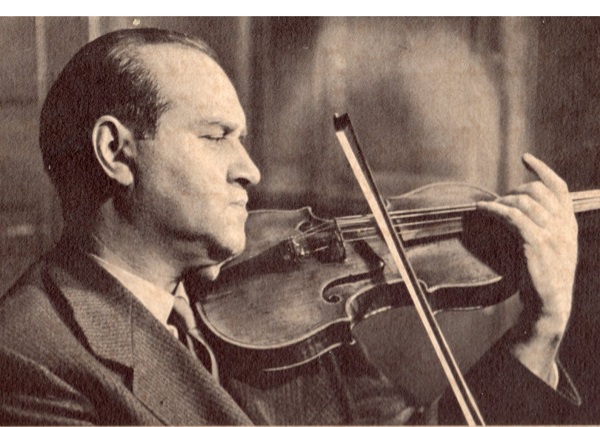
Sonate n°1 Op.12 n°1: Vladimir Yampolsky, piano (Prague 26 avril 1954) Supraphon ALPV 244
Sonate n°3 Op.12 n°3: Vladimir Yampolsky, piano (Bruxelles 19 &20 mai 1955) Angel 35331
Sonate n°4 Op.23: Alexander Goldenweiser, piano (Moscou 17 avril 1950) Akkord D-07893
Sonate n°5 Op.24: Lev Oborin, piano (Moscou 1950) Akkord D-07894
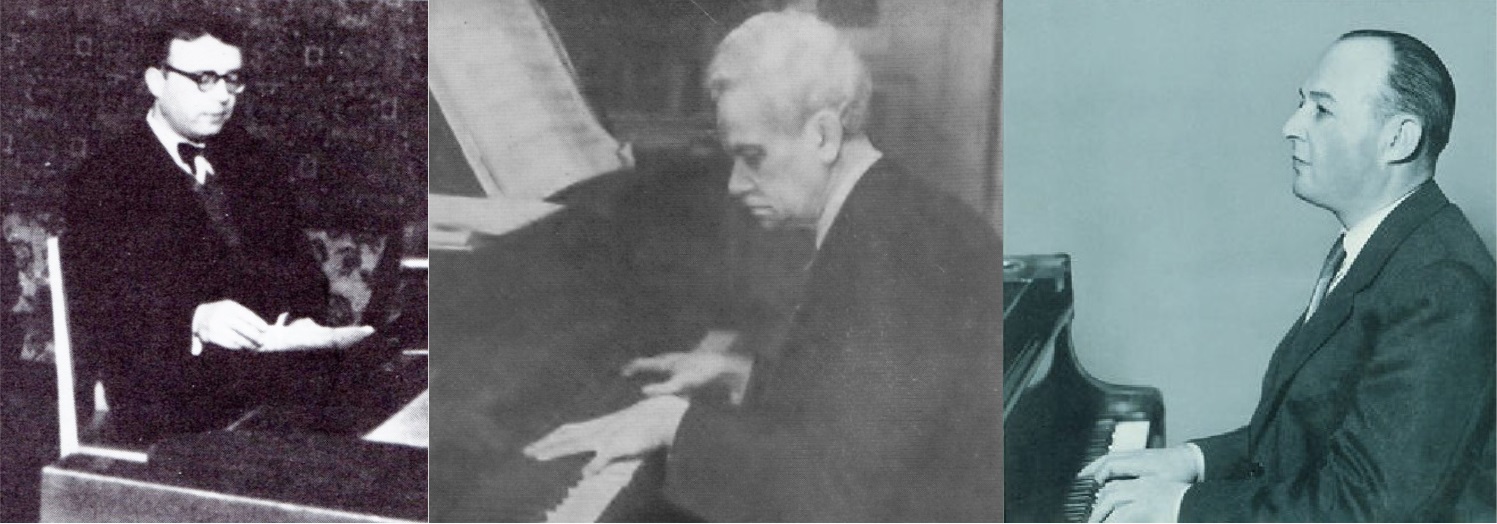
Lev Oborin, Alexander Goldenweiser & Vladimir Yampolsky
David Oïstrakh, né à Odessa (Ukraine) en 1908 et décédé à Amsterdam (Pays-Bas) en 1974, a enregistré à Paris en mai-juin 1962 avec le pianiste Lev Oborin (1907-1974) une célèbre intégrale des Sonates violon-piano de Beethoven après les avoir données en concert à la Salle Pleyel. Cet ensemble a fait l’objet de nombreuses rééditions à tel point que l’on a quasiment oublié l’existence de disques antérieurs. Aussi bien ces enregistrements de studio que les enregistrements des concerts (publiés par Doremi) montrent que ces interprétations sont en retrait par rapport aux enregistrements précédents d’Oïstrakh de huit de ces sonates réalisés entre 1949 et 1955 avec au piano Vladimir Yampolsky (1905-1965) pour les sonates n°1 et 3, Alexander Goldenweiser (1875-1961) pour la sonate n°4 et Lev Oborin (1907-1974) pour les cinq autres (n°5, 7 , 8, 9 et 10).
Si quatre d’entre elles (n°4, 5, 7 et 8) ont été enregistrées à Moscou, les quatre autres (n°1, 3, 9 et 10) l’ont été respectivement à Prague (pour Supraphon), à Bruxelles (pour EMI), à Paris (pour Le Chant du Monde) et à New-York (pour Columbia), et cette multiplicité d’éditeurs n’a pas permis une publication globale de cette quasi-intégrale.
Or, en dépit de la présence de trois pianistes différents et d’une dispersion des dates ainsi que des lieux et donc aussi des équipes d’enregistrement, on constate une grande homogénéité entre ces interprétations, ce qui signe l’indépendance d’esprit de David Oïstrakh. Nous vous les proposons en trois groupes à partir des microsillons d’origine.
____________
David Oïstrakh, born in Odessa (Ukraine) in 1908 and deceased in Amsterdam (Netherland) in 1974, has recorded in Paris in May-June 1962 with pianist Lev Oborin (1907-1974) a well-known complete version of Beethoven’s violin-piano Sonatas shortly after a series of concerts at Salle Pleyel. It has been re-issued many times so that the very existence of earlier recordings has been almost forgotten. The studio recordings as well as the concert performances (released by Doremi) show that these are much less convincing that the earlier Oïstrakh recordings of eight of the sonatas made between 1949 and 1955 with pianists Vladimir Yampolsky (1905-1965) for sonatas n°1 and 3, Alexander Goldenweiser (1875-1961) for sonata n°4 and Lev Oborin (1907-1974) for the other five (n°5, 7 , 8, 9 and 10).
If four of them (n°4, 5, 7 and 8) were recorded in Moscow, the other four (n°1, 3, 9 and 10) were made in Prag (for Supraphon), in Brussels (for EMI), in Paris (for Le Chant du Monde) and in New-York (for Columbia), and this multiplicity of editors did not permit an overall re-issue of this fast complete series.
In spite of three different pianists and of a dispersion of the dates as well as of the recording countries and for that matter also of the recording teams, there is a great homogeneity in the performances which accounts for David Oïstrakh’s independent mind. We propose them in three groups from the original LPs.
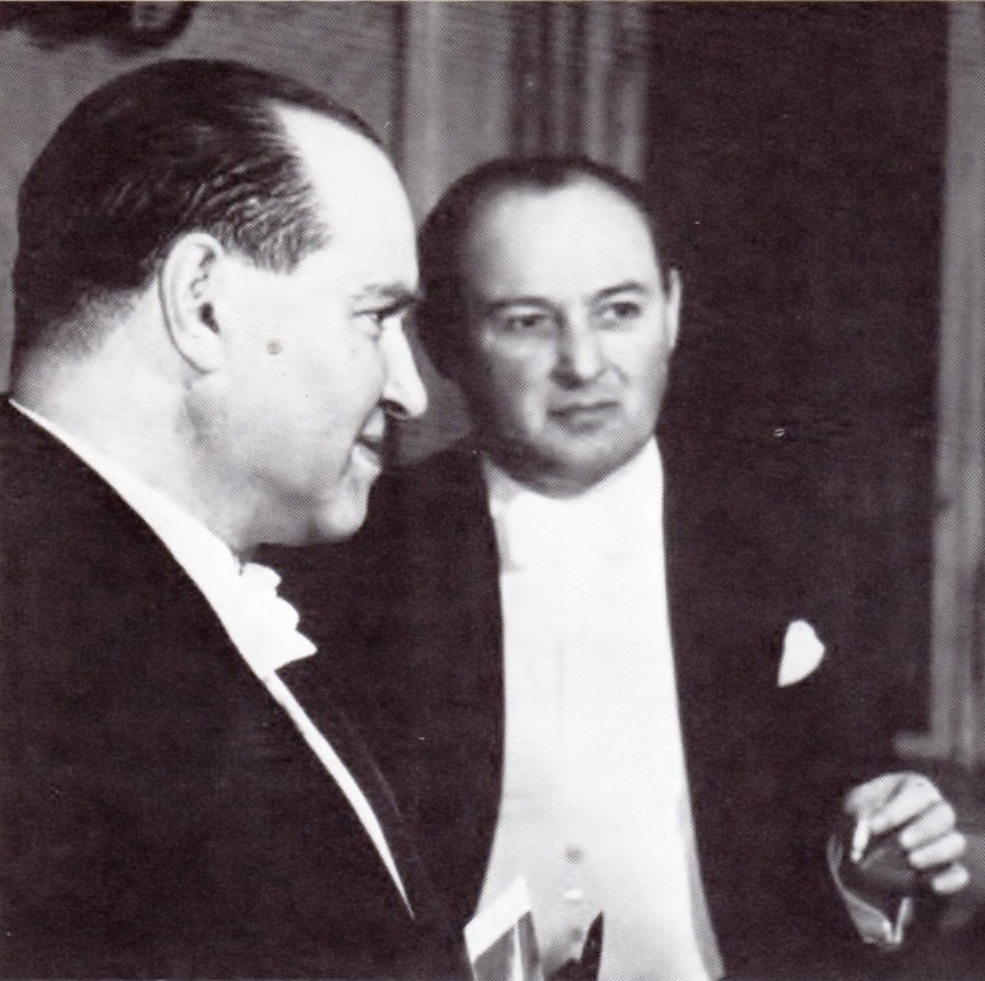
David Oïstrakh & Vladimir Yampolsky



